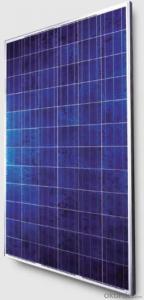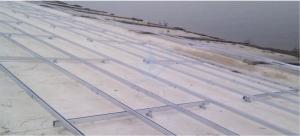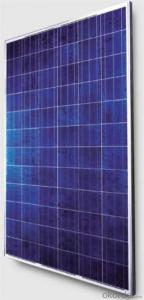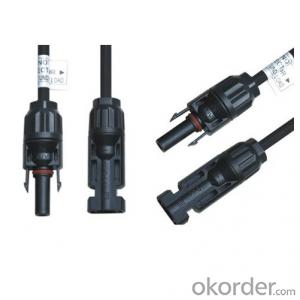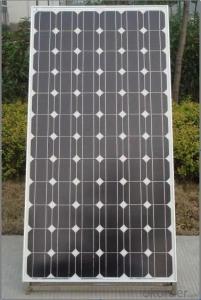Solar Vacuum Tube PV Modules Made in China for Overseas Market
- Loading Port:
- Tianjin
- Payment Terms:
- TT OR LC
- Min Order Qty:
- 1 pallet
- Supply Capability:
- 100000000 pallet/month
OKorder Service Pledge
OKorder Financial Service
You Might Also Like
Solar panel refers either to a photovoltaic (PV) module, a solar hot water panel, or to a set of solar photovoltaic modules electrically connected and mounted on a supporting structure. A PV module is a packaged, connected assembly of solar cells. Solar panels can be used as a component of a larger photovoltaic system to generate and supply electricity in commercial and residential applications. Each module is rated by its DC output power under standard test conditions, and typically ranges from 100 to 320 watts. The efficiency of a module determines the area of a module given the same rated output – an 8% efficient 230 watt module will have twice the area of a 16% efficient 230 watt module. There are a few solar panels available that are exceeding 19% efficiency. A single solar module can produce only a limited amount of power; most installations contain multiple modules. A photovoltaic system typically includes a panel or an array of solar modules, an inverter, and sometimes a battery and/or solar tracker and interconnection wiring.
Solar modules use light energy (photons) from the sun to generate electricity through the photovoltaic effect. The majority of modules use wafer-based crystalline silicon cells or thin-film cells based on cadmium telluride or silicon. The structural (load carrying) member of a module can either be the top layer or the back layer. Cells must also be protected from mechanical damage and moisture. Most solar modules are rigid, but semi-flexible ones are available, based on thin-film cells.
Electrical connections are made in series to achieve a desired output voltage and/or in parallel to provide a desired current capability. The conducting wires that take the current off the modules may contain silver, copper or other non-magnetic conductive transition metals. The cells must be connected electrically to one another and to the rest of the system. Externally, popular terrestrial usage photovoltaic modules use MC3 (older) or MC4 connectors to facilitate easy weatherproof connections to the rest of the system.
Bypass diodes may be incorporated or used externally, in case of partial module shading, to maximize the output of module sections still illuminated.
Some recent solar module designs include concentrators in which light is focused by lenses or mirrors onto an array of smaller cells. This enables the use of cells with a high cost per unit area (such as gallium arsenide) in a cost-effective way.

Specifications:
solar panels from 5W--300W, made of TAIWAN MOTECH brand cells,with CO in TAIWAN,Mono and Poly with VDE,IEC,CSA,UL,CE,ISO.
We import solar cells from Taiwan Motech brand, with this CO in taiwan and our CSA certification,we can still sell goods to Anti-dumping areas like USA. Our main products are solar panels, off grid and on grid solar home systems , solar street lighting systems, solar water heating system,solar pump,solar attic fan, solar DC LED lights and solar DC refrigerators.
Certificates : ISO, CE, VDE IEC, MCS, CSA-UL, CEC.
Delivery time: sample 10days, order 25-30days.
Sample: charged.
Payment term: T/T 30% as deposit, 70% before shipment. Or irrevocable L/C at sight.
Trade term: FOB Shenzhen or CIF destination seaport or Airport.
Characteristics:
I.Solar Cell : High efficiency crystalline solar cell. Even if under the weak light, the solar module can produce maximum power output.
II.Tempered glass (toughened glass): Anti-reflecting coating and high transmission rate glass increase the power output and mechanical strength of solar module.
III.EVA and TPT: Using high quality EVA and TPT to prevent destroying and water.
IV.AI frame: Without screw, corner connection. 6 holes on the frame can be installed easily.
V.Junction box: Multi function junction box with water proof.
VI.Long lifetime: ≥25 years; Less power decrease.
VII.Good performance of preventing from atrocious weather such as wind and hails.
VIII.Resisting moisture and etching effectively, not effected by geology.
IX.The certificate issued by international authority: UL, TUV, IEC, VDE, CE.

Quality and Safety
1. Rigorous quality control meets the highest international standards.
2. High-transmissivity low-iron tempered glass, strong aluminium frame.
3. Using UV-resistant silicon.
4. IS09001/14001/CE/TUV/UL
Warranties
1. 10 years limited product warranty
2. 15 years at 90% of the minimal rated power output
3. 25 years at 80% of the minimal rated power output
Technical date :
ITEM NO.: | Poly 156*156 cell ,60pcs . Power range from 230Wp-260Wp | ||||||
Maximum Power(W) | 230 | 235 | 240 | 245 | 250 | 255 | 260 |
Optimum Power Voltage(Vmp) | 29.4 | 29.5 | 29.7 | 30.1 | 30.3 | 30.5 | 30.7 |
Optimum Operatige Current(Imp) | 7.83 | 7.97 | 8.08 | 8.14 | 8.25 | 8.37 | 8.48 |
Open Circuit Voltage(Voc) | 36.7 | 36.8 | 36.9 | 37.1 | 37.3 | 37.5 | 37.7 |
Short Circuit Current(Isc) | 8.52 | 8.59 | 8.62 | 8.65 | 8.69 | 8.73 | 8.78 |
Solar Cell: | 156*156 Poly | ||||||
Number of Cell(pcs) | 6*10 | ||||||
Name of Solar Cells | Polycrystalline Cell | ||||||
Size of Module(mm) | 1650*992*40/45/50 | ||||||
Cable & Connector Type | Pass the TUV Certificate | ||||||
Frame(Material Corners,etc.) | Aluminium-alloy | ||||||
Back sheet | TPT | ||||||
Weight Per Piece(KG) | 19.5KG | ||||||
FF (%) | 70-76% | ||||||
Junction Box Type | Pass the TUV Certificate | ||||||
Tolerance Wattage(e.g.+/-5%) | ±3%, or 0-3% | ||||||
Front Glass Thickness(mm) | 3.2 | ||||||
Temperature Coefficients of Isc(%) | +0.04 | ||||||
Temperature Coefficients of Voc(%) | -0.38 | ||||||
Temperature Coefficients of Pm(%) | -0.47 | ||||||
Temperature Coefficients of Im(%) | +0.04 | ||||||
Temperature Coefficients of Vm(%) | -0.38 | ||||||
Temperature Range | -40°C to +85°C | ||||||
Surface Maximum Load Capacity | 5400Pa | ||||||
Allowable Hail Load | 23m/s ,7.53g | ||||||
Bypass Diode Rating(A) | 12 | ||||||
Warranty | 90% of 10 years, 80% of 25 years. | ||||||
Standard Test Conditions | AM1.5 1000W/ 25 +/-2°C | ||||||
Packing | carton or pallet | ||||||
1*20' | 14 Pallets / 316pcs | ||||||
1*40'STD | 25 Pallets / 700pcs | ||||||

FAQ:
I..Will you focus on the safety of the goods during transportation?
Yes, Safety of the cargo is the primary element that we would consider on transportation.
II..How would guarantee the quality will meet the requirements of your clients?
Before shipment, we will have inspection for each batch of goods.
III..What certificates do you have?
IEC,UL,TUV,CSA,etc.
IV..Can you do OEM according to clients’ requirements?
Yes, we have our own brand while we can provide OEM service.
- Q: How do solar vacuum tubes affect property value?
- Solar vacuum tubes can positively affect property value by increasing its energy efficiency and reducing utility costs. They are a sustainable and eco-friendly solution for heating water and providing space heating. These systems can also be attractive to environmentally conscious buyers, potentially making the property more desirable and increasing its market appeal.
- Q: Are solar vacuum tubes resistant to hail and other weather conditions?
- Yes, solar vacuum tubes are generally resistant to hail and other weather conditions. The outer glass layer of the vacuum tube is designed to withstand impact from hailstones and other external forces. Additionally, the vacuum insulation and sturdy construction of the tubes provide protection against adverse weather conditions, making them durable and suitable for various climates.
- Q: Are solar vacuum tubes resistant to hail or extreme weather conditions?
- Yes, solar vacuum tubes are generally resistant to hail and extreme weather conditions. They are designed to withstand hailstorms and are made from durable materials that can withstand high winds, heavy rain, and extreme temperatures. However, it is important to note that the degree of resistance may vary depending on the specific brand and quality of the vacuum tubes.
- Q: Are solar vacuum tubes suitable for use in museums or art galleries?
- Yes, solar vacuum tubes are suitable for use in museums or art galleries. They provide a reliable and efficient source of natural lighting while minimizing harmful UV rays and heat that could potentially damage artwork or artifacts. Additionally, the aesthetic design of solar vacuum tubes blends well with the architecture of these spaces, making them an excellent choice for creating an inviting and sustainable environment.
- Q: Can solar vacuum tubes be used for electronics or semiconductor production?
- No, solar vacuum tubes are primarily designed for capturing solar energy for heating purposes and are not suitable for electronics or semiconductor production.
- Q: How to clean the vacuum tube of solar water heater
- The first wind ring vacuum tube from the mouth of the dial is more than and 10 cm, and holding the bottom of the vacuum tube is 1/3, both hands simultaneously in one direction screw, screw vacuum tube, turned left or right into the water tank, feeding tube, the tail tail frame, the vacuum tube and to pull ourselves, then wash with water vacuum tube.
- Q: Are solar vacuum tubes suitable for areas prone to earthquakes?
- Solar vacuum tubes are generally considered suitable for areas prone to earthquakes. These tubes are designed with sturdy materials and can withstand moderate seismic activity. However, it is essential to ensure proper installation and anchoring to ensure their stability during earthquakes. Additionally, regular inspections and maintenance might be required to ensure the tubes remain intact and functional in earthquake-prone regions.
- Q: How do solar vacuum tubes perform in areas with high levels of air pollution and industrial emissions?
- Solar vacuum tubes may not perform optimally in areas with high levels of air pollution and industrial emissions. The pollutants and particles in the air can potentially block or diminish the amount of sunlight reaching the vacuum tubes, reducing their efficiency and heat absorption capabilities. Regular cleaning and maintenance may be required to ensure the tubes continue to perform effectively in such environments.
- Q: Can solar vacuum tubes be used for snow melting?
- Yes, solar vacuum tubes can be used for snow melting. The vacuum tubes absorb sunlight and convert it into heat, which can be used to melt snow on various surfaces such as roofs, driveways, and walkways.
- Q: Are solar vacuum tubes suitable for areas with high air pollution?
- Solar vacuum tubes may not be the most suitable option for areas with high air pollution. Air pollution can reduce the efficiency of solar panels and vacuum tubes by blocking sunlight and accumulating dirt on the surface, hampering their performance. Regular cleaning and maintenance may be required to ensure optimal functioning in polluted areas.
Send your message to us
Solar Vacuum Tube PV Modules Made in China for Overseas Market
- Loading Port:
- Tianjin
- Payment Terms:
- TT OR LC
- Min Order Qty:
- 1 pallet
- Supply Capability:
- 100000000 pallet/month
OKorder Service Pledge
OKorder Financial Service
Similar products
Hot products
Hot Searches
Related keywords
